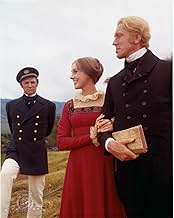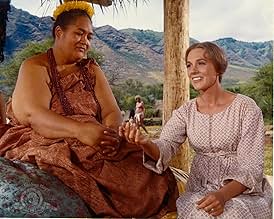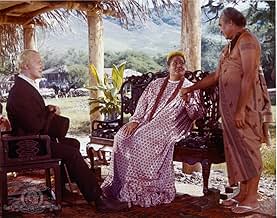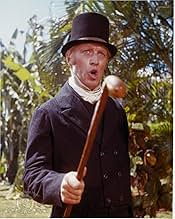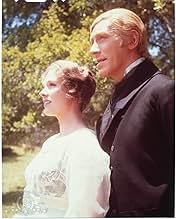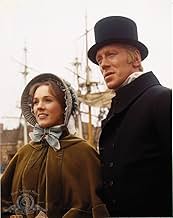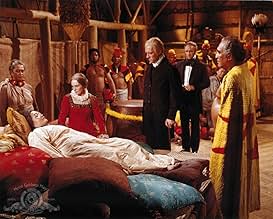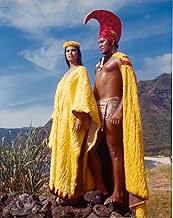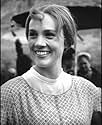Ajouter une intrigue dans votre langueAn American missionary and his wife travel to the exotic island kingdom of Hawaii, intent on converting the natives. But the clash between the two cultures is too great and instead of unders... Tout lireAn American missionary and his wife travel to the exotic island kingdom of Hawaii, intent on converting the natives. But the clash between the two cultures is too great and instead of understanding there comes tragedy.An American missionary and his wife travel to the exotic island kingdom of Hawaii, intent on converting the natives. But the clash between the two cultures is too great and instead of understanding there comes tragedy.
- Réalisation
- Scénario
- Casting principal
- Nommé pour 7 Oscars
- 2 victoires et 10 nominations au total
- Charity Bromley
- (as Diane Sherry)
Avis à la une
The movie is only about one-fifth of the whole book. Too bad. The movie leaves a lot of unresolved plot threads which are resolved later in the book. Subplots which seem inconsequential turn out to have major implications to the plot of the novel. Minor characters from the movie become more important as the story progresses. For example, Gene Hackman's Dr. John Whipple and Richard Harris' Raefer Hoxworth have only a few scenes in Hawaii, but their characters are perhaps the two most important characters in the book. Whipple and Hoxworth are the ones who challenge the authority of the missionaries and, in a sense, are the true foils to Abner Hale. They also are the ones who go into business.
As a result, the movie, standing by itself, tends to introduce characters and subplots with no relevancy to the main Abner-Jerusha-Malama-Keolo story line. Perhaps a sequel was planned? In short, Hawaii would have worked better as a mini-series.
********************* How the Novel Ends:
Abner Hale's son, Micah, who was last seen getting a boat to the mainland to attend Yale University, becomes a minister like his father. The sea captain, Raefer Hoxworth, marries Noelini, the daughter of the Alii Nui. Micah then meets and falls in love with Raefer's and Noelini's daughter. They get married. Abner Hale scorns Micha; claiming the Micah has gone "whoring with the heathens." Micah quits the ministry and becomes a partner in Raefer Hoxworth's shipping company - now called Hoxworth and Hale.
John Whipple and Retire Janders (the captain of the ship that brought the missionaries to Hawaii) are partners in Janders & Whipple. Initially a trading company, general store, and ship chandler, they start acquiring land and growing sugar. J&W eventually becomes a plantation company and needs cheap labor to work their fields. John Whipple imports Chinese workers.
A generation after the movie ends, the descendants of Hale, Whipple, Janders, Hewlett (the man who was kicked out of the church for marrying a Hawaiian woman) and the Hoxworth are the commercial, social, and political elite of Hawaii. Micah Hale leads the movement to have the United States annex Hawaii and serves as the first governor of the Territory of Hawaii.
The descendants of these families continue to build their businsses and develop the islands. In an ironic twist, the families, refusing to marry Hawaiians or Chinese, intermarry. Eventually cousins marry cousins - the very practices Abner Hale condemned from his puplit. You eventually get characters named: Whipple Hoxworth; Hoxworth Hale; Hewlett Janders; Bromley Hoxworth.
Finally, at the end of the novel the rich, post-WW II descendants of the missionaries talk about their "distinguished ancestors." Their descriptions and interpretation of events, differs from what it portrayed in the earlier chapters.
Gene Hackman in early role
Directors George Roy Hill Arthur Hiller(temporarily replaced director) Writers James A. Michener(novel) Dalton Trumbo(screenplay) Daniel Taradash(screenplay) Stars Julie Andrews Max von Sydow Richard Harris Julie Andrews and Jocelyne LaGarde in Hawaii (1966)
Two cultures collide in this vast, lavish and truly spectacular film Adapted from James A. Michener's Pulitzer Prize-winning novel and nominated* for seven Oscars, this "majestic, gorgeously climatic epic with adventuresome picture-making, a credit to the industry"; and riveting entertainment! They came to bring God, but instead brought disease and destruction. The Rev. Abner Hale (Von Sydow) and his gentle wife Jerusha (Andrews) attempt to convert early 19th-century Hawaiian natives to Christianity but find themselves ill-equipped to endure the unexpected tribulations of paradise. Surging with the excitement of windstorms, firestorms, shark attacks and magnificent island scenery, Hawaii shines as passionately as the island paradise itself!
Julie Andrews and Max von Sydow in Hawaii (1966)
1966: It received seven nominations at the 39th Academy Awards: Best Supporting Actress (Nominated- Jocelyne LaGarde), Best Cinematography- Color (Nominated), Best Costume Design-Color (Nominated), Best Sound (Nominated), Best Effects- Visual Effects (Nominated), Best Music-Original Song (Nominated), Best Music-Original Music Score (Nominated) I think this film is worth seeking out ! It is on blu-ray/DVD.and multiple streaming /Tubi, Prime 7.8/10 Great Movie Poster!
Julie Andrews' acting abilities shine as bright as the tropical sun in this story of a New England woman who accompanies her stodgy husband to the islands on a mission to convert the heathens. Andrews' buoyant on-screen persona is held in check here (as it is in the overly criticized "Darling Lili"), making her Jerusha a quiet heroine. Her childbirth scene is effective for the visceral reaction it creates, and she's got one whopping good speech toward the end, where she finally gives her stick-in-the-mud hubby what-for.
Von Sydow, who would work with Andrews again later in "Duet for One," is all bluster and bellowing, condemning just about everyone he comes in contact with. I find the performance rather one-note; however, the opening scenes in which Hale tries to woo the lovely Jerusha are sweetly awkward.
Richard Harris shows up as a long-lost sea captain in one of moviedom's most impossible coincidences. Harris is all fire and passion, exactly the kind of third-party that a juicy love triangle needs.
George Roy Hill's direction keeps things moving at a brisk pace, despite the lengthy running time. He had a gorgeous palette to paint with, and he takes full advantage. The sea trek--complete with storms--suffers from some very obvious blue-screening, but Hill manages to build an appropriate sense of excitement.
I'm also going to carp with costumer Dorothy Jeakins. Andrews costumes are lovely (but consider what Jeakins had to work with), but Von Sydow goes running throughout the movie with his stove-pipe hat cemented onto his head. Works okay for the New England settings, but once the cast hits the beach, he ends up looking like some kind of absurd Dr. Doolittle (Hugh Lofting's, creation, not Eddie Murphy's).
Jeakins also makes a very brief appearance (her role was trimmed mightily) as Hale's mother.
While on the subject of the supporting players, LaGarde had no acting experience whatsoever (and, hence, drove the production schedule and budget way off base), but she's utterly charming. She more than earned her Oscar nomination.
Funny to see a pre-Archie Carroll O'Connor in the New England sequences. Also watch for Heather Menzies as one of Jerusha's younger sisters. Two years earlier, she had played Louisa von Trapp to Andrews' Maria. Gene Hackman's here, too, as a put-upon doctor.
One last note: If you're going to seek out this treasure, please, please, please opt for the widescreen version. The rocking of the boat sickened many of the passengers on their way to paradise, and likewise, the pan-and-scan version will sicken viewers of this terrific epic.
Le saviez-vous
- AnecdotesJocelyne LaGarde is the only performer in Academy Award history to be nominated for her only screen role. LaGarde had never acted before, and never acted again in her entire life.
- GaffesWhen Jerusha is in labor Abner times her contractions very closely with his pocket watch. Most pocket watches in the 1820's had no second hands, particularly one owned by a poor missionary.
- Citations
Dr. John Whipple: [Addressing Abner, while holding Keoki's lifeless body, victim of the measles epidemic that has ravaged the native Hawaiians] There's nothing you could've done for him... When Captain Cook discovered these islands 50 years ago, they were a true paradise. Infectious disease was unknown. They didn't even catch cold! And there were 400,000 of them - now there are less than 150,000. You and I may well live to see the last Hawaiian lowered into his grave - with proper Christian services, of course.
- Versions alternativesOriginal version ran 189 minutes; subsequently cut to 171 minutes. The general release version ran 151 minutes. Full-length version available on home video.
- ConnexionsFeatured in The Dick Cavett Show: Julie Andrews/Blake Edwards (1971)
Meilleurs choix
Détails
- Date de sortie
- Pays d’origine
- Langues
- Aussi connu sous le nom de
- Hawaii
- Lieux de tournage
- Bodo, Norvège(Missionary boat saing thru Magellan Straits)
- Sociétés de production
- Voir plus de crédits d'entreprise sur IMDbPro
Box-office
- Budget
- 15 000 000 $US (estimé)
- Durée
- 3h 9min(189 min)
- Couleur
- Rapport de forme
- 2.35 : 1


